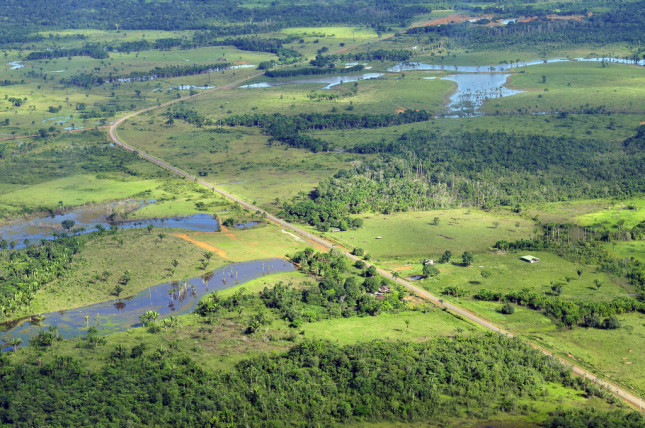-
Warning: The Amazon May Soon Reach the Point of No Return on Forest Loss
October 23, 2018 By Evan Barnard
“What we do during this decade can be critical for the future of Amazonia,” said São Paulo Research Foundation member, Paulo Artaxo, at a recent Wilson Center event on efforts to support sustainability and development in the Amazon region. The recently accelerating environmental change in the Amazon region warrants greater collaboration between the civil and scientific communities on community and international scales, according to a panel of experts.
A Fragile but Critical Earth Indicator
As Artaxo defines it, Amazonia is “a unique region” with global effects on the hydrological cycle (the continuous cycle of water exchange between the earth and atmosphere), carbon balance, and socioeconomic issues. Considered an indicator of Earth’s health, Amazonia used to take in more carbon dioxide from the atmosphere than it emitted. The region is now more carbon neutral, with roughly equal carbon dioxide inputs and outputs. Forest clearing and land degradation are in part responsible for this and they represent top priorities of research in Amazonia.
The hydrological cycle of the Amazon is critical for the agricultural sector of South America. Amazonian atmospheric conditions bring moisture from the Atlantic down across the continent to the agricultural regions in Peru and Argentina, but deforestation—or the clearing of natural forests—and other types of degradation are altering the atmospheric conditions and disrupting precipitation patterns. Through a cascade of effects, deforestation leads to an increase in temperatures and shifts in regional precipitation norms.
Collecting Data from the Sky
“From the very beginning, land use has been at the heart of our discussions because human activity across the Amazon frontier is an incredibly important driver of change,” said Douglas Morton, a NASA Earth scientist at the Goddard Space Flight Center. He described how remote sensing and satellite technology, in particular open-source data, can be used to help scientists learn more about factors affecting the sustainability of biodiverse regions like the Amazon. “The availability of satellite data has really spurred an incredible amount of innovation,” he said.
One way these technologies can be used to learn more about deforestation is satellite imagery to track forest fires. It is actually possible to get insight into the motivation behind a new deforestation event by observing what happens to a clearing over time using satellite data, Morton said. NASA currently uses satellites to collect Earth data, and one of its new initiatives is using airplanes equipped with LiDAR (Light Detection and Ranging) remote sensing instruments to create 3-dimensional maps of fly-over zones to better understand biomass—the total amount of living organisms in a given area—and other measurements. Remote sensing enables scientists to measure what might otherwise remain unseen to track and learn about deforestation.
Approaching a Tipping Point
Some scientists project the Amazon will reach a tipping point, or the point beyond which changes to the region become irreversible, in the near future. “Obviously it makes no sense to find out where the tipping point is by tipping it,” said Thomas Lovejoy, a senior fellow at the UN Foundation. According to Artaxo, the factors largely responsible for the Amazon’s movement toward the tipping point include higher forest fire frequency, longer dry seasons, and increased climate extremes.
Different studies and models have been used to predict the tipping point of hydrological and deforestation-generated degradation. In 2007, Sampaio et al. projected that Amazonia would reach a tipping point at about 40 percent deforestation, but a much more recent evaluation estimates the tipping point could occur with as low as 20 percent to 25 percent forest conversion, or deforestation of forest land for economic purposes. The over exploitation of ecosystem services, the contributions ecosystems directly or indirectly make to human wellbeing, may be leading to permanent changes in the natural biogeochemical and hydrological cycles in the Amazon.
Even with such a danger on the horizon, the Amazon has the potential to extensively reduce greenhouse gas emissions in a relatively cost-effective way. The cost would involve curbing deforestation and increasing socioeconomic development in rural populations. The imprint of human activity’s footprint is larger than we’ve previously recognized, said Morton, “[and] the legacy of that activity is long-lasting and important, whether we’re talking carbon, or biodiversity, or land value.”
Neutralizing human-driven forest loss would not be easy. Five million hectares of conversion, formerly natural forested land subsequently used for commercial production, must be removed annually from corporate supply chains to end deforestation, and despite company commitments, commodity-driven deforestation has not declined.
“We also have to be discussing the local challenges there,” said Rita Mesquita, a senior researcher at the National Institute of Amazon Research. Since no panacea exists for the Amazonian situation, “more than ever we know the solution is going to be necessarily interdisciplinary.” In order to take a thorough, inclusive approach to addressing the issues facing the Amazon, she said, “it’s very important that we establish and strengthen our connections to everybody and anyone that is interested in discussing alternative ways to deal with the Amazon.”
Sources: Annual Reviews, ClientEarth, Geophysical Research Letters, Global Environmental Change Journal, Global Forest Watch, McKinsey & Company, Nature Journal, Science Advances, Science Daily, Science Magazine, The Economics of Ecosystems and Biodiversity, University of Illinois at Urbana-Champaign
Photo Credit: Aerial view of the Amazon Rainforest, near Manaus, the capital of the Brazilian state of Amazonas. April 2011. Photo by Neil Palmer (CIAT).
 A Publication of the Stimson Center.
A Publication of the Stimson Center.



